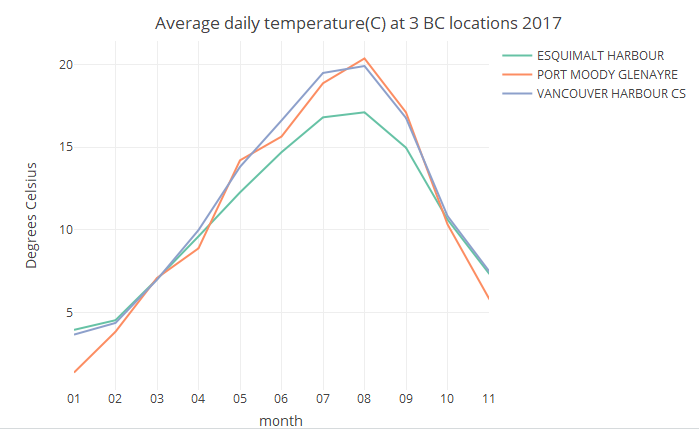After a long spate of just soccer posts, it is a relief(delayed pun intended) to turn to a quick look at a relatively new package, weathercan released under the https://ropensci.org/ banner by [@steffilazerte](Steffi LaZerte), who has written a comprehensive blog post about it
The package provides historical weather data from Environment and Climate Change Canada’s website.
Many years ago, I briefly lived in Victoria, BC, Canada and recalled it as a very agreeable climate so moving to North Vancouver I was expecting much of the same. It does not feel like that (: and this package gives me a chance to see if my subjective assessment of unremitting gloom - at least for several months of the year - is justified
Let’s first see what weather stations are currently available in BC and that provide at least daily returns
## # A tibble: 222 x 8
## station_name station_id lat lon elev interval start end
## <chr> <fct> <dbl> <dbl> <dbl> <chr> <int> <int>
## 1 CHEMAINUS 26 48.9 -124. 75.0 day 1919 2018
## 2 COWICHAN LAKE FORES~ 37 48.8 -124. 177. day 1949 2018
## 3 DISCOVERY ISLAND 27226 48.4 -123. 18.9 day 1997 2018
## 4 ESQUIMALT HARBOUR 52 48.4 -123. 3.00 day 1957 2018
## 5 GALIANO NORTH 55 49.0 -124. 6.00 day 1975 2018
## 6 MALAHAT 65 48.6 -124. 366. day 1920 2018
## 7 METCHOSIN 68 48.4 -124. 164. day 1911 2018
## 8 NORTH COWICHAN 76 48.8 -124. 45.7 day 1981 2018
## 9 NORTH COWICHAN 46728 48.8 -124. 44.8 day 2007 2018
## 10 NORTH PENDER ISLAND 77 48.8 -123. 98.0 day 1972 2018
## # ... with 212 more rowsSo the data provided includes a location and elevation (in metres)
Let’s first see what weather stations are currently available near where I live and that provide at least daily returns
## # A tibble: 13 x 9
## station_name station_id lat lon elev interval start end
## <chr> <fct> <dbl> <dbl> <dbl> <chr> <int> <int>
## 1 N VANC GROUSE MTN R~ 823 49.4 -123. 1.10e3 day 1971 2018
## 2 N VANCOUVER WHARVES 833 49.3 -123. 7.00e0 day 1962 2018
## 3 VANCOUVER HARBOUR CS 888 49.3 -123. 2.50e0 day 1925 2018
## 4 BURNABY SIMON FRASE~ 731 49.3 -123. 3.66e2 day 1965 2018
## 5 WEST VANCOUVER AUT 6833 49.4 -123. 1.70e2 day 1992 2018
## 6 PORT MOODY GLENAYRE 834 49.3 -123. 1.30e2 day 1970 2018
## 7 POINT ATKINSON 844 49.3 -123. 1.40e1 day 1968 2018
## 8 RICHMOND OPERATIONS~ 48448 49.2 -123. 1.60e1 day 2010 2018
## 9 RICHMOND DALLYN 2 853 49.2 -123. 1.80e0 day 1963 2018
## 10 RICHMOND NATURE PARK 837 49.2 -123. 3.00e0 day 1977 2018
## 11 VANCOUVER INTL A 51442 49.2 -123. 4.30e0 day 2013 2018
## 12 VANCOUVER SEA ISLAN~ 51357 49.2 -123. 2.11e0 day 2013 2018
## 13 DELTA BURNS BOG 49088 49.1 -123. 3.11e0 day 2011 2018
## # ... with 1 more variable: distance <dbl>Unfortunately, there is nothing on my doorstep (actually maybe just as well) I know from this handy site that the elevation at my location is 142 metres
Data provided by weather stations is inconsistent, so I want to be sure that the chosen station(s) will provide what I am after. Let’s look at what variables are potentially available from local stations and how well they were covered in, say, January 2018
## [1] "station_name" "station_id" "lat"
## [4] "lon" "elev" "climate_id"
## [7] "WMO_id" "TC_id" "prov"
## [10] "date" "year" "month"
## [13] "day" "qual" "cool_deg_days"
## [16] "cool_deg_days_flag" "dir_max_gust" "dir_max_gust_flag"
## [19] "heat_deg_days" "heat_deg_days_flag" "max_temp"
## [22] "max_temp_flag" "mean_temp" "mean_temp_flag"
## [25] "min_temp" "min_temp_flag" "snow_grnd"
## [28] "snow_grnd_flag" "spd_max_gust" "spd_max_gust_flag"
## [31] "total_precip" "total_precip_flag" "total_rain"
## [34] "total_rain_flag" "total_snow" "total_snow_flag"
So around half the stations have no missing data. 834 is at a comparable elevation and 888 not too far away - but at sea level
From a similar process for the Victoria area I obtain another station 52, Esquimalt Harbour at sea level, which seems a good choice
Now lets get precipitation and temperature data for a full year, 2017, for these three locations
This shows quite a variation between the sites. Comparing the two sea level locations, Vancouver’s total annual rainfall of 1.5m is two and a half times that that of Esquimalt(0.6). Higher up in the clouds - at least for these locations - adds a further 0.2m
How about temperatures?
Interstingly, the summers are 2-3C hotter on the mainland, with the elevated station averaging 0.4 degrees lower than Vancouver Harbour over the year as a whole
For me, the slightly warmer winters do not really make up for the significant increase in rainfall so maybe it’s time to move back to Vancouver Island. Still there is more to life than the climate…
